
It's not just about looking at the teeth, but considering the overall growth of a child's mouth.
That is what "Kouiku" is.
Bad habits of the tongue or misaligned teeth can delay the development of the muscles around the mouth, leading to a smaller jaw or a receding lower jaw.
As a result, the airway narrows, and the function of breathing weakens.
Oxygen is an essential element for the body's movement.
Not being able to breathe properly means that nutrients won't be distributed throughout the body effectively, and concentration can decrease.
As a result, it is said to cause issues with learning and physical abilities.
This is not just a problem during the growth period.
People whose muscles around the mouth are less developed than others tend to experience a significant decline in oral function as they age, increasing the risk of eating and swallowing disorders.
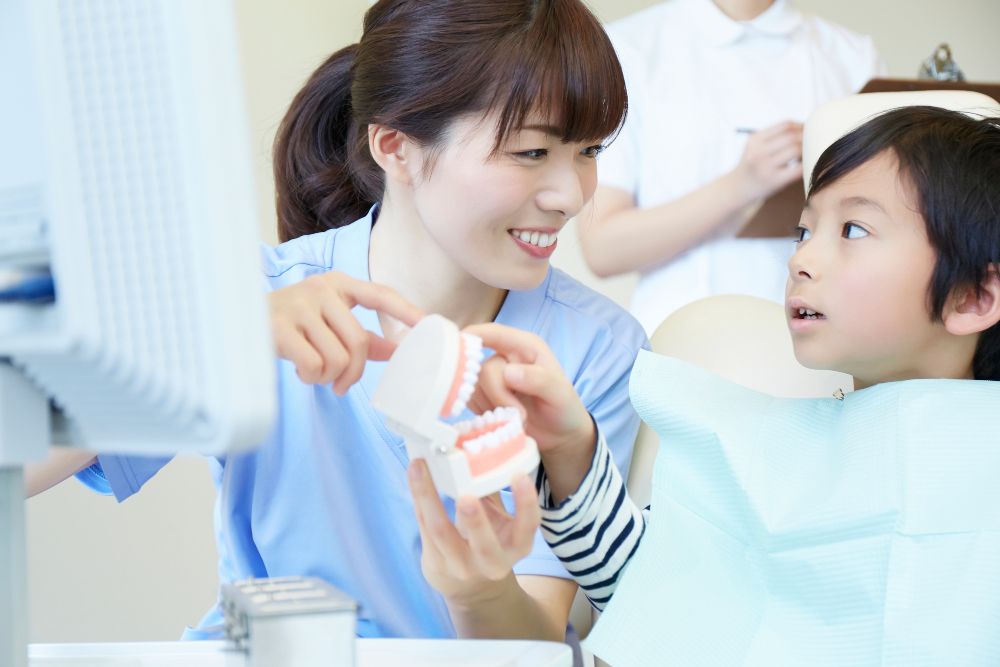
Our clinic implements the concept of "Kouiku" in pediatric dentistry to support the growth and development of oral functions from childhood.
From the time teeth begin to appear, we work to correct bad habits that hinder normal breathing and swallowing, preventing mouth breathing, misaligned teeth, and obstructive respiratory disorders.
We support the proper growth and development of oral functions. Our clinic focuses on pediatric dentistry based on the concept of "Kouiku."
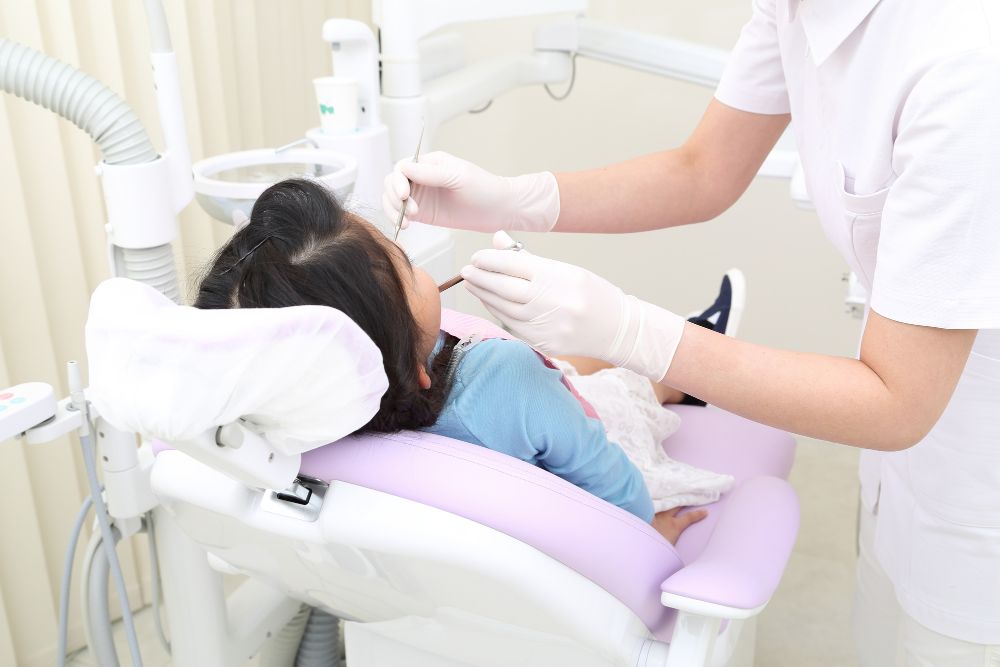
For children's cavity prevention, make sure to visit the dentist once your child turns 2 year old.
Our clinic does not force treatment on children.
By communicating that "this is not a scary place," we do not instill fear of dentistry in children.
Doing so becomes a step towards having them visit us for prevention throughout their lives.
For this reason, we have a flexible system that divides children into two groups based on their age, and we may even change the hygienist depending on the case.
For your child's first dental visit, please consult Torinomori Dental Care.
By following the 3 steps below, brushing becomes easier, enabling effective self-care.
After these steps, depending on the patient's wishes, we perform a saliva test (saliva examination) and propose a cavity prevention program tailored to each individual.
first
2
3
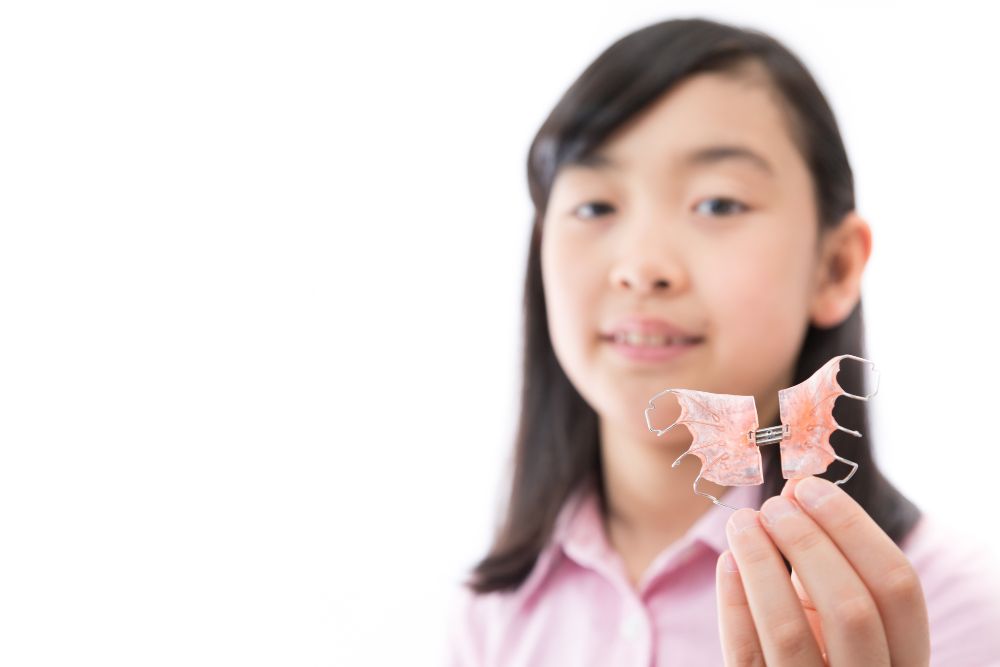
About 80% of children in Japan are said to have misaligned teeth.
Why is this the case? Previously, it was mostly believed that dental alignment was due to genetics.
However, examining many children, it's noticeable that the proportion with poor dental alignment is increasing.
If genetics were the only factor, the proportion of children with poor dental alignment would not increase.
The real cause is environmental factors such as diet, thumb sucking, nail-biting, mouth breathing, and poor posture.
Misaligned teeth increase hard-to-brush areas, significantly raising the risk of cavities and periodontal disease.
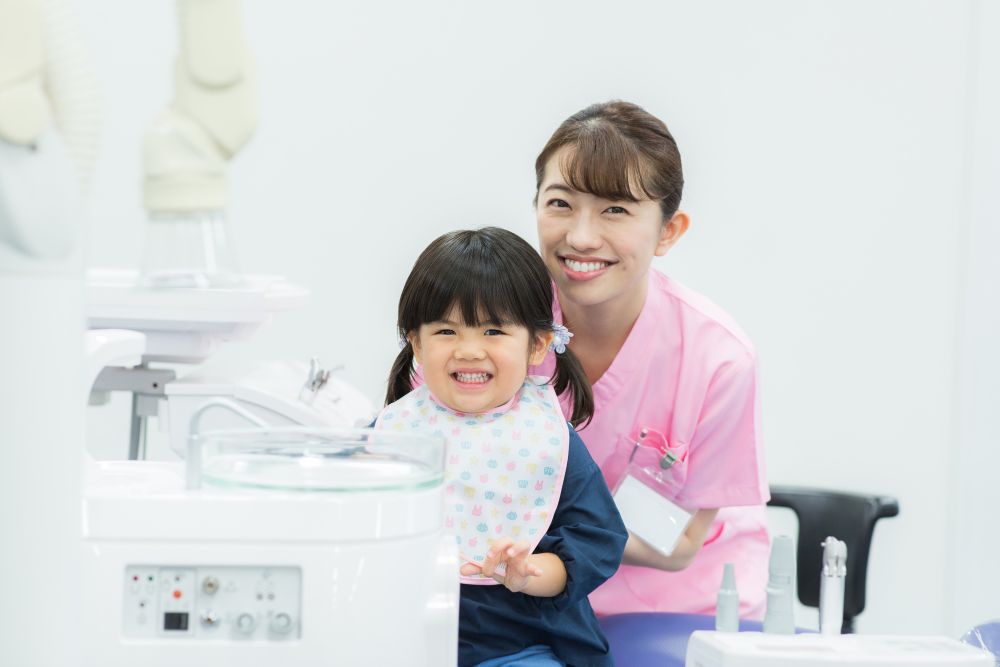
Additionally, as they grow, it becomes clear that misaligned teeth can lead to adverse effects such as shoulder and back pain, and decreased concentration and immunity due to mouth breathing.
Therefore, correcting bad habits early can lead to proper dental alignment and healthy development.
For this reason, our clinic focuses on preventive orthodontics for children, especially recommending myofunctional orthodontic devices.
Preventive orthodontics for children is orthodontic treatment carried out in advance to prevent misaligned teeth.
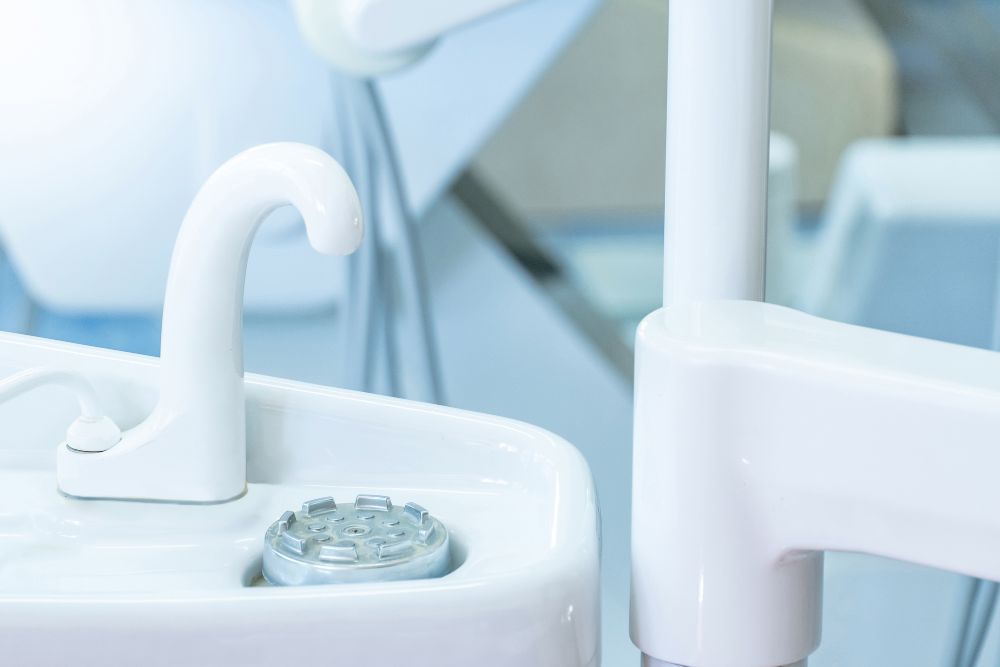
Regarding "MRC" orthodontics, our clinic recommends a myofunctional orthodontic device called "MRC" for preventive orthodontics in children.
This involves using a removable orthodontic device called a trainer to train the tongue and jaw, aiming to harmonize the muscles around the mouth, not only for proper dental alignment but also for the overall health and natural growth of the mouth.
During homework, playing games, or watching TV, use it for ~ hours at any preferred time during the day. And use it while sleeping.
Because it's removable, maintenance is easy.
Although it's an unapproved medical device in Japan, treatment is conducted in accordance with the guidelines of the Australian headquarters.
Regarding membership, only dental clinics that meet the membership criteria are recognized, so please consult us with confidence as we have ample achievements and clinical experience.
The age to start "MRC" orthodontics and myofunctional therapy is from 4 to 5 years old.
However, future dental alignment predictions and training can be performed even before that age, so you can visit us at ages 2 or 3.
The benefit of "MRC" is that it corrects the bad habits that are the root cause of dental misalignment.
By adjusting muscle function and improving posture and mouth breathing, it can remove various adverse health effects in the future.
If you have any concerns about your child's health, please contact us as soon as possible.
First, we will provide detailed materials at the front desk.
After thoroughly considering it at home, if you wish to hear more details, we will conduct an initial counseling session.
We will explain the treatment philosophy, treatment period, and what kind of procedures will be performed in an easily understandable manner through videos, so please feel free to ask any questions.
During that time, we will also discuss the treatment timeline and costs.
Depending on the case, we may conduct detailed examinations, such as radiography, on the same day to check the number of permanent teeth and propose a treatment method suited to your child.
At this stage, treatment has not yet begun, so you can take your time to consider how to proceed.
If treatment is decided upon, rest assured that we will thoroughly check the inside of the mouth and proceed with myofunctional orthodontic device treatment after treating any cavities or other issues.
Myofunctional orthodontic devices are not like traditional orthodontics that force teeth into alignment with wires.
It corrects and aligns the habits and muscles that cause poor dental alignment from the root.
Because it is removable and involves training, cooperation between the child and parents is essential.
Our clinic will support you wholeheartedly, so let's work together to achieve healthy teeth.
For patients who have undergone orthodontic treatment at our clinic, we offer a discount campaign for Invisalign.
Qualifying patients can receive Invisalign treatment at a discount equivalent to the cost of their previous orthodontic treatment (treatment fees).
For more details, please contact us.

Did you know that the mouth of a newborn child does not contain mutans streptococci, the bacteria that cause cavities? So, where does a baby get cavity-causing bacteria from? It comes from the mouths of parents and family members.
When a baby's teeth begin to emerge and they switch to solid foods, practices like sharing food mouth-to-mouth or kissing can increase the risk of transmitting cavity-causing bacteria from an infected person to the child.
This means that the oral environment of the mother or father is likely directly linked to the child's oral environment.
Therefore, our clinic emphasizes the importance of parents maintaining a clean oral environment above all else.
Along with cleaning, we propose a saliva test (saliva examination) to clarify the condition of cavity-causing bacteria and the risk of infection.
To protect your child's teeth, why not receive dental treatment for the whole family?

Since newborns cannot choose or consume food on their own, nor can they take care of their teeth, it's said that they are most likely to come into contact with mutans streptococci from their mother, with whom they spend the most time. Especially between the ages of 1.5 to 2 years, when the baby molars are coming in, is considered the most susceptible period for mother-to-child transmission, known as the "window of infectivity."
Postpartum, mothers may continue to be busy, which could lead to neglecting tooth brushing or leading an irregular lifestyle, potentially worsening the oral environment again.
During such times, maintaining oral hygiene through professional dental cleaning and fluoride application at the dental clinic is advisable.
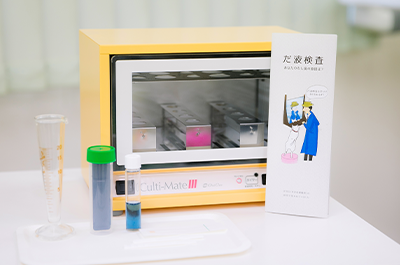
Saliva test counseling, where staff accept dental inquiries, can resolve questions like "Why do I get cavities despite brushing properly?" and "How high is my risk of getting cavities?" through a saliva test (saliva examination).
The method is very simple. You quietly produce saliva while chewing gum to measure the saliva volume. Additionally, by examining the neutralizing power of saliva and the number of cavity-causing bacteria, it can determine whether the environment is prone to cavities, which helps in deciding how to proceed with prevention measures.

During breastfeeding and weaning food guidance, counseling staff accept dental inquiries. It's important to pay attention to the correct way to open the mouth and the angle to prevent "shallow sucking" during breastfeeding.
If a habit of shallow sucking during nursing is formed, it can affect the way the tongue moves and the use of mouth muscles, impacting jaw development.
Parents might feed their child using the same chopsticks or spoon they use, which can transfer cavity-causing and periodontal disease bacteria, making the oral hygiene of parents also important.
Also, when feeding weaning food, ensure it is of moderate softness and be careful not to insert the spoon too far into the mouth. This encourages natural practice of "biting," "chewing," and "swallowing."
Even casual actions can become daily habits, so remembering the important points from the beginning is okay.

The aim of the Body Harmony Class is to acquire balanced muscle strength and moderate flexibility as your child grows.
Body development is equal to brain development. By supporting physical and mental development, we aim to improve towards a balanced body.
We will provide advice from the perspective of a dental clinic.

Maternal dentistry recognizes that pregnant mothers are more susceptible to cavities and periodontal disease due to hormonal changes.
It is said that a deteriorated oral environment increases the risk of premature and low-birth-weight babies, so caring for your mouth during this period can contribute to the health of the unborn baby in terms of habits and hygiene.
This is what our clinic advocates as "Cavity Prevention from Minus One Year Old."
This prevention method is not only about dental care during this period but also because irregular dietary habits and poor nutritional status of the mother can lead to an oxidized oral environment, weakening the baby's teeth. Therefore, we recommend the intake of minerals such as calcium and phosphorus and suggest regular dental check-ups.

Please feel free to contact us with any questions you may have regarding your oral health.